Drawing as a Tool for Thinking: The Back of the Napkin
 Lately I've been reading Dan Roam's The Back of the Napkin: Selling Ideas and Solving Problems Through Pictures. In the book, Roam asserts that drawing pictures can help you solve problems. It's a simple but profound assertion.
Lately I've been reading Dan Roam's The Back of the Napkin: Selling Ideas and Solving Problems Through Pictures. In the book, Roam asserts that drawing pictures can help you solve problems. It's a simple but profound assertion.
You're no doubt familiar with the same assertion with writing. Writing is a tool for thinking, a method for unlocking ideas. Writing about something helps you think about it, helps you see the problem more clearly, helps you see what you're trying to say. Most people who write know this. It's what teachers in writing courses tell students who dislike writing—that even if you're not going to be a writer, writing is a worthwhile skill because it extends your critical thinking faculties.
Roam essentially says drawing provides much the same critical thinking tool.
It sounds cool, but does it really work? I decided to give it a try. Here's the problem I was trying to solve. Next month I'm giving a five-hour WordPress workshop in Vienna (as part of the TransAlpine conference). Five hours is a long time. If I stand up there and lecture, not only will I collapse from exhaustion after three hours, everyone else will either leave or fall asleep. Also, the room won't have Internet. How can I keep people awake and engaged?
Roam has a specific heuristic to follow when drawing. Not only should you explore the 6 W's—the who, when, why, what, how / how many, and where—you should also look at various angles: simple versus elaborate, quality versus quantity, vision versus execution, individual versus comparison, and change versus as-is.
I decided to keep it simple and mostly focus on the first set of questions, but you can imagine how each of these angles would prompt a different inquiry. Here's what I drew.

As you can see, I'm not an artist, but that's okay, Roam says, because the purpose of these drawings is to analyze and explore the problem, not to represent something aesthetically.
My chicken-scratch drawings may look unintelligible, but they did help me consider solutions and additional facets of the problem that I hadn't previously considered. While I was drawing, here are some of the ideas I thought about.
In drawing the how, I realized (and this may be small) that I'll need a long cord to extend to the projector if the projector is in the back of the room. I doubt the room is set up that way, but drawing it made me think about the layout of the room and what technical problems I may encounter. If I need sound, how will I orchestrate that? What problems will the 220 current from European outlets pose for my American equipment? Will I set my laptop on a table beside me or on a slanted podium?
In drawing the why, I realized that I'll be filling the participants with enthusiasm and excitement for WordPress, but if there's no outlet, no way of putting that enthusiasm into practice, it will be an exercise in frustration. I'll need some practice problems for everyone to follow. To facilitate practice with WordPress offline, I'll have to walk them through local installations of WordPress on their own computer through something like WAMP server.
In drawing the what, I decided I'll need a workbook of some kind for the participants to follow along. The workbook will give structure to the course and provide a safety blanket for people who may feel they're not entirely getting a concept. I already started on a WordPress Quick Reference Guide last year, so perhaps I should update it, extend it, and illustrate it with more pictures.
In drawing the how many, I realized that of the 20 to 30 people who might attend the course, the participants will likely have a variety of technical backgrounds, from people who can't code a hyperlink to people employed as professional web designers. I need to be aware of the different skill levels and start from the ground up, assume that many will have little understanding of CSS and later move into advanced concepts.
In drawing the how many, I also realized that not everyone may be planning to use WordPress as a blogging tool, but might be looking to use it to sell products, build a chapter site, or implement it for some other purpose. I know that's a somewhat obvious point, but I didn't think about it until I drew forty separate audience members, each of whom looked a little different.
So you see, drawing out various scenarios, answering the who, when, what, why, where, how, and how many, did bring up some important issues and help prompt some solutions. Drawing really is a tool for thinking, a heuristic for investigating ideas.
Part of the reason drawing works, I believe, is because our visual sense is critical to the way we understand the world. It's how we process what happens around us. As children, we instinctively draw. The urge is unstoppable. Even as bad as the pictures are, we don't care. I can't help but think that, unconsciously, children draw to help make sense of the world, to understand what they're seeing and to express what they're feeling.
Perhaps we draw less as we learn to write, but drawing does not provide the same analytical results as the written word—it's another sense and medium. As a unique medium, the answers are often unique as well. Whatever the reason, drawing as a tool for thinking does give you another tool for solving problems. (And it's a great excuse to doodle on paper.)
About Tom Johnson

I'm an API technical writer based in the Seattle area. On this blog, I write about topics related to technical writing and communication — such as software documentation, API documentation, AI, information architecture, content strategy, writing processes, plain language, tech comm careers, and more. Check out my API documentation course if you're looking for more info about documenting APIs. Or see my posts on AI and AI course section for more on the latest in AI and tech comm.
If you're a technical writer and want to keep on top of the latest trends in the tech comm, be sure to subscribe to email updates below. You can also learn more about me or contact me. Finally, note that the opinions I express on my blog are my own points of view, not that of my employer.

